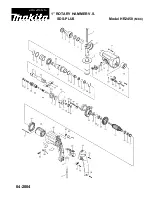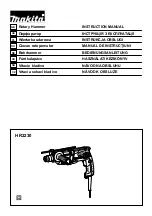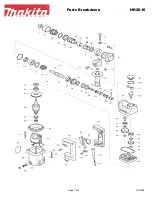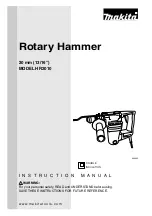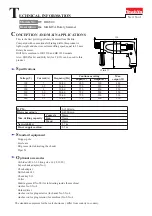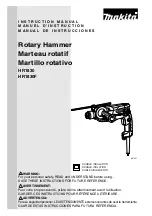
5
WARNING:
MISUSE or failure to follow the safety rules stated in
this instruction manual may cause serious personal
injury.
FUNCTIONAL DESCRIPTION
CAUTION:
• Always be sure that the tool is switched off and
unplugged before adjusting or checking function on the
tool.
Switch action (Fig. 1)
CAUTION:
• Before plugging in the tool, always check to see that
the tool is switched off.
• Switch can be locked in “ON” position for ease of
operator comfort during extended use. Apply caution
when locking tool in “ON” position and maintain firm
grasp on tool.
Speed change (Fig. 2)
The blows per minute can be adjusted just by turning the
adjusting dial. This can be done even while the tool is
running. The dial is marked 1 (lowest speed) to 5 (full
speed).
Refer to the table below for the relationship between the
number settings on the adjusting dial and the blows per
minute.
NOTE:
• Blows at no load per minute becomes smaller than
those on load in order to reduce vibration under no
load, but this does not show trouble. Once operation
starts with a bit against concrete, blows per minute
increase and get to the numbers as shown in the table.
When temperature is low and there is less fluidity in
grease, the tool may not have this function even with
the motor rotating.
CAUTION:
• The speed adjusting dial can be turned only as far as 5
and back to 1. Do not force it past 5 or 1, or the speed
adjusting function may no longer work.
Indicator lamp (Fig. 3)
The green power-ON indicator lamp lights up when the
tool is plugged. If the indicator lamp does not light up, the
mains cord or the controller may be malfunction. The
indicator lamp is lit but the tool does not start even if the
tool is switched on, the carbon brushes may be worn out,
or the controller, the motor or the ON/OFF switch may be
malfunction.
The red service indicator lamp flickers up when the
carbon brushes are nearly worn out to indicate that the
tool needs servicing. After approx. 8 hours of use, the
motor will automatically be shut off.
ASSEMBLY
CAUTION:
• Always be sure that the tool is switched off and
unplugged before carrying out any work on the tool.
Side handle (auxiliary handle) (Fig. 4)
The side handle can be swung 360° on the vertical and
secured at any desired position. It also secures at eight
different positions back and forth on the horizontal. Just
loosen the clamp nut to swing the side handle to a desired
position. Then tighten the clamp nut securely.
Installing or removing the bit (Fig. 5)
Clean the bit shank and apply bit grease before installing
the bit.
Insert the bit into the tool. Turn the bit and push it in until it
engages.
(Fig. 6)
If the bit cannot be pushed in, remove the bit. Pull the
releasing cover down a couple of times. Then insert the
bit again. Turn the bit and push it in until it engages.
(Fig. 7)
After installing, always make sure that the bit is securely
held in place by trying to pull it out.
To remove the bit, pull the releasing cover down all the
way and pull the bit out.
(Fig. 8)
Bit angle (Fig. 9)
The bit can be secured at 12 different angles. To change
the bit angle, slide the change ring cover forward, then
turn the change ring cover to change the bit angle. At the
desired angle, slide the change ring cover back to the
original position. The bit will be secured in place.
OPERATION
Chipping/Scaling/Demolition (Fig. 10)
Always use the side grip (auxiliary handle) and firmly hold
the tool by both side grip and switch handle during
operations. Turn the tool on and apply slight pressure on
the tool so that the tool will not bounce around,
uncontrolled. Pressing very hard on the tool will not
increase the efficiency.
MAINTENANCE
CAUTION:
• Always be sure that the tool is switched off and
unplugged before attempting to perform inspection or
maintenance.
Lubrication
CAUTION:
• This servicing should be performed by Makita
Authorized or Factory Service Centers only.
This tool requires no hourly or daily lubrication because it
has a grease-packed lubrication system. However, it is
recommended to periodically replace the grease for
longer tool life.
First, switch off and unplug the tool.
(Fig. 11)
Number on adjusting dial
Blows per minute
5
1,900
4
1,700
3
1,450
2
1,200
1
950





















